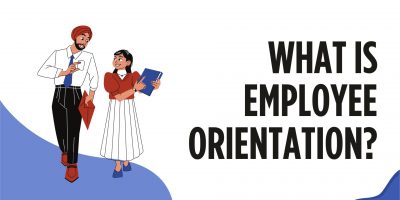
What is Employee Orientation?
“You only get one chance to make a first impression.” As the old saying is still true today, learn how to create a new employee orientation program to set up your new employees for success.


President at KOM Growth
Entering parenthood marks the start of a new phase– it’s one of life’s greatest joys, but it can also be an incredibly challenging time filled with many adjustments. With significantly more single-parent and dual-working households in the workforce, American workers must find a way to balance family caregiving responsibilities and work obligations.
To support and help parents thrive, many countries and employers around the world provide workers with paid parental leave after having a new baby.
However, the US is the only wealthy country in the world without national, statutory, paid family leave.
The consequences of a lack of parental leave in the US are far too apparent in the real world. On so many measures of family hardship, children and their parents suffer more than their counterparts in other wealthy countries.
In this article, we explore the critical importance of parental leave in the US, shedding light on its impact on families and businesses. We delve into the complexities of existing policies, highlighting the challenges employers and employees face.
Parental leave is an employee benefit that allows parents and caregivers to take time off work to care for a new baby. Well-designed leave policies help workers adjust during the first few years of their child’s life without the fear of losing their employment status or experiencing poverty at a critical and vulnerable point in the child’s development.
However, the definition of who qualifies as a parent is a major point of confusion when it comes to parental leave.
Traditionally, parental leave has been offered to birth parents, foster parents, and adoptive parents. Yet, the family unit has evolved over the years, and there are now many different types of families, such as blended families and non-traditional households.
Current legislation has been slow to keep up with the realities of American families and update parentage laws, which can create additional stress and confusion for new parents.
As if that’s not enough, parental leave in the US is a complex web of laws and regulations that varies widely from one state to another, so employers and prospective parents might have difficulty understanding their rights and responsibilities.

The idea of paid parental leave is not so controversial in other countries, with 96% of 186 countries offering paid maternity leave and 44% offering paid paternity leave. However, many workers in the United States are not guaranteed a single paid day of leave, and many do not qualify even for unpaid leave.
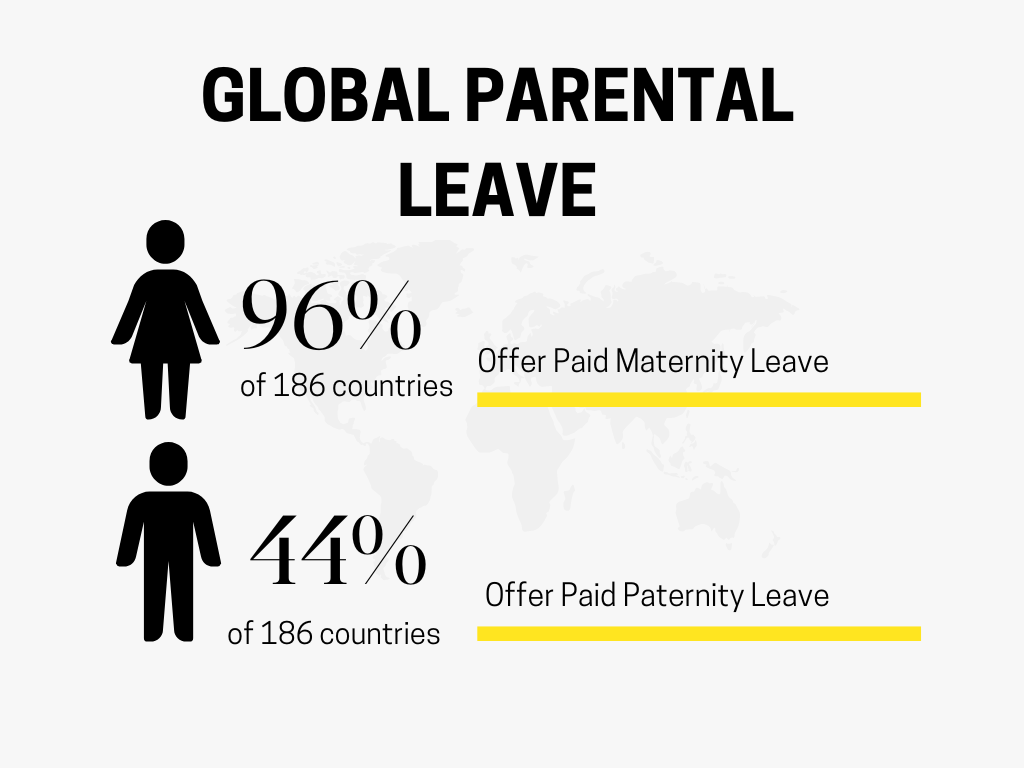
Families and parents are eligible under the Family and Medical Leave Act (FMLA) for up to 12 weeks of unpaid leave. However, the actual average amount of maternity leave companies give in the U.S. is 29 days, or just over four weeks.
The FMLA was passed in 1993 and applies to all public agencies and private businesses with 50 or more employees. To be eligible for FMLA leave, an employee must:
The FMLA has undoubtedly been a lifeline for millions of workers who need to take time off work for a qualifying reason. However, only half of the workforce (56%) is eligible, as small employers are exempt and not all employees at covered employers are eligible.
Furthermore, it is also important to note that the FMLA does not provide paid leave.
Maternity leave statistics show that one in four women return to work after only two weeks of giving birth due to financial pressures. For these reasons, employees who take FMLA leave often stack their leave or take their paid time off, like sick days or vacation days, to get paid during their leave.
Luckily, there is also some good news.
Several US states have introduced employment laws that provide paid or partially paid family leave. These laws may be more generous than the FMLA and may apply to smaller employers. The length of parental leave also varies, with some states offering 12 weeks, others offering eight weeks, and a few offering only five weeks.
Employers who understand the government regulations around parental leave in the US, such as the FMLA, can avoid costly compliance issues.
In addition, they can also make their organization more attractive to potential and current employees by implementing compliant FMLA policies and procedures or by creating supplemental employer-paid parental leave policies of their own.
Time and time again, research shows the benefits of parental leave and why employers and policymakers need to strongly consider paid parental leave.
For starters, when parents have the time to care for their children, the whole family’s physical and mental health is improved. Babies whose parents go on leave are more likely to be breastfed, get their vaccinations on time, and experience fewer hospitalizations.
On top of allowing mothers to heal physically, taking leave is beneficial for their mental health. When mothers took less than 12 weeks of maternity leave, they had higher postpartum depression scores (15%) and a higher probability of severe depression at nine months post-delivery.
However, paid leave is more than a women’s issue.
Leave is beneficial for strengthening family relationships and fostering stable partnerships, too. Studies have shown that parent-child bonding is crucial to a baby’s healthy development, especially in the first four to six months of life.
When fathers take leave, they are more likely to be involved in feeding, changing diapers, bathing, and other caregiving tasks. This early bonding can help create a strong foundation for the child’s development and lead to a more involved father later in life.
Moreover, when both parents can take time off work, the mother’s mental health and well-being drastically improve.
Unfortunately, the average American father only gets one week of leave, and many fathers work long hours and have long commutes, which makes it difficult for them to be as involved in their children’s lives as they would like.
While employee benefits are well documented, a business case can also be made that links paid leave to a company’s financial outcome and workforce productivity.
Expanding leave programs can be a strategic way to attract and retain top talent as job seekers increasingly value these benefits.
A recent survey found that 82% of Americans believe that employees should be able to take paid maternity leave, including adoption leave. To compete for top talent, businesses need to offer generous family leave policies that are inclusive of all workers.
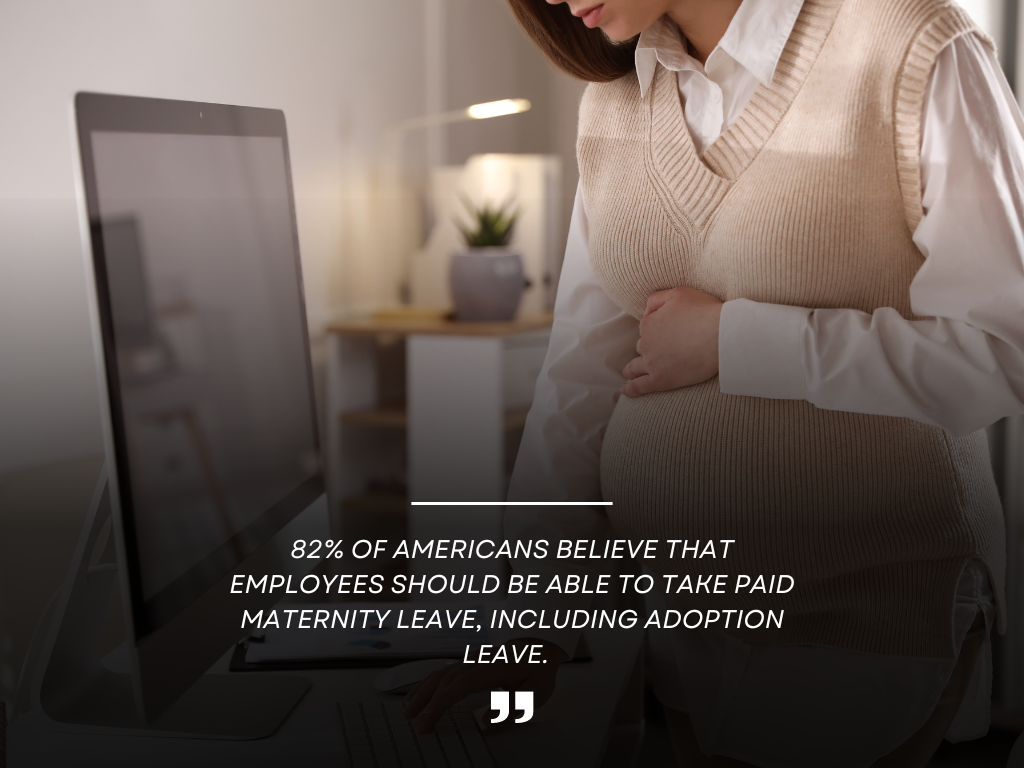
Parental leave can also help organizations reduce employee turnover and absenteeism and improve retention rates. A study by the Center for Women and Work found that the employee retention and productivity benefits of such policies equal or outweigh their costs to employers.
As if that’s not enough, research by Panorama and the American Sustainable Business Council found that employer-paid parental leave policies and programs were linked with higher firm profitability.
Finally, embracing paid leave ensures increased female workforce participation by providing job stability, empowers women in the workplace, and contributes to narrowing the gender wage gap.
America’s lack of family support is a widely acknowledged problem that negatively impacts families and businesses.
“This country is traditionally horrible at parental leave for both parents,” shared Rob LaHayne, President at KOM Growth.
He further explains, “We have short maternity leave programs that often require women to come back to work while their bodies are still in physical shock – let alone mental anguish.
Many employers offer little to no paternity leave. And we have an aging population that will need care over the next 10-15 years from their Millennial and Gen Z children because long-term care is too unaffordable.”
LaHayne argues that if employers want to attract and retain talent, they need to implement effective policies and tools to allow employees to achieve work-life balance.
Surprisingly, while the nation is widely polarized, parental leave is a rare issue that unites Americans across the political spectrum. Campaigns like #showusyourleave have rapidly gained traction on the internet and shown how valuable transparent benefits are to employees and job seekers.
In recent years, we have seen an upward trend in companies offering modernized leave benefits. While the decision of whether to offer paid leave benefits is up to employers, many businesses now recognize the importance of access to paid parental leave in the US.
As per SHRM’s 2023 Employee Benefits Survey, 40% of employers offer paid maternity leave, while paid paternity leave saw a five percent increase, now provided by 32% of employers. In addition, paid parental leave is now offered by nearly four in every ten employers (39%), a six-point jump this year.
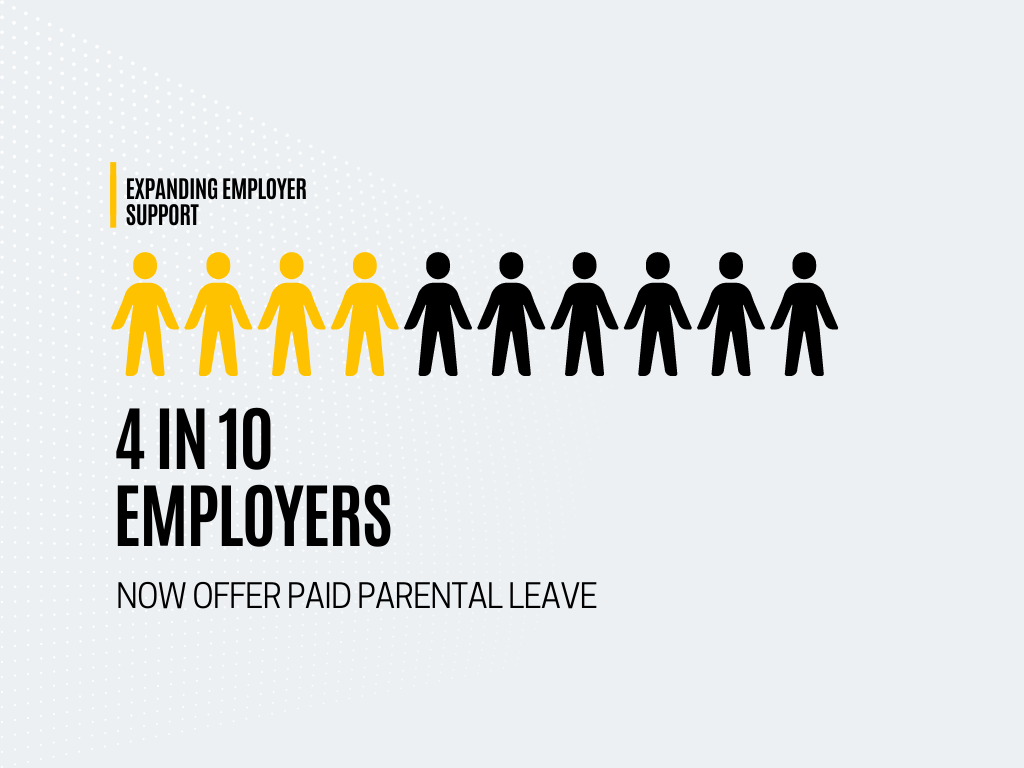
However, employers are now responsible for addressing the increasing expectations from both potential hires and current staff.
As more and more employers offer these benefits, they must ensure that their policies are fair, inclusive, and equitable for all employees. In other words, it means company-specific policies should not discriminate based on gender, sexual orientation, or family structure.
In addition to offering paid leave, employers should consider job protection for employees during their leave period and guarantee their jobs when they return.
By 2025, millennials are expected to make up 75% of the global workforce.
Millennials stand out for their distinctiveness from earlier generations, and this is particularly evident in their outlook on work-life balance and family dynamics. Millennials value flexibility and family-friendly policies more than previous generations.
A study by EY found that 83% of millennial respondents in the United States said they would be more likely to join a company offering flexibility and parental leave.
Therefore, in addition to paid leave and job protection, there are other ways that employers can support employees and their families. For example, employers can offer:
Without clearly defining and communicating leave policies, employers invite potential issues down the road. What happens when an employee out on leave requests for extended time off?
Or what if they need to take leave unexpectedly?
For these reasons, employers create a comprehensive document that delves into all the specifics of their parental leave policy.
An internal leave policy includes laying out the eligibility criteria, the duration of the leave, available benefits, the ins and outs of the application process, and a step-by-step guide to the return-to-work procedure.
Ensure this document is easy to access, preferably in employees’ handbooks.
While a parental leave policy is a valuable benefit, it is only one piece of the puzzle.
Employers also need to create a company culture where employees feel comfortable taking leave and are not penalized for doing so. When employees know what to expect, they are more likely to feel confident taking the break they need and more likely to be productive when they return to work.
Employers can ensure employee buy-in by organizing workshops or sessions that break down parental leave policies, highlight the perks, and underscore the significance of maintaining a healthy work-life balance.
Finally, encourage workers who’ve taken parental leave before to share their experiences with their co-workers. It creates a sense of camaraderie and offers real-world insights into juggling work and family.
The transition to parenthood can be a taxing time for working parents.
On top of preparing to care for a new child, many parents also find preparing for parental leave difficult and overwhelming.
In fact, 42% of working parents find the process of preparing for parental leave to be moderately to extremely burdensome.
While planning for parental leave can be daunting, it doesn’t have to be. Here is a practical step-by-step guide to help employees have a smooth transition:
The Great Resignation, quiet quitting, and tech layoffs have dominated headlines, but a less-discussed workforce trend is the mass exodus of parents after returning from parental leave.
According to one study, nearly 30% of women without access to family-paid time off (PTO) dropped out of the workforce within a year of giving birth, and one in five did not return for over a decade. The rate of new parents leaving their jobs due to lack of support is slightly higher than the rate of resignations caused by the Great Resignation movement.

Effective communication is essential for a smooth reintegration to work for parents after parental leave. An employee’s availability and needs may have changed after the arrival of a newborn, so it is important to avoid making assumptions about what they can and cannot do.
In addition, their professional priorities may be different after their leave. After time off work, employees are out of the loop on project updates, company policies, or even broader business goals.
To reintegrate, employers should have an updated onboarding plan, or re-boarding, that provides revised, clear job responsibilities, including any changes.
Like onboarding a new employee, managers should schedule regular check-ins with returning parents to stay up-to-date on their progress, identify concerns, and provide support.
Finally, employee recognition is vital for a positive return to work.
Employers should celebrate every employee’s return, make them feel welcome, and let them know how much they value their contributions.
A parent-friendly workplace understands and supports the needs of working parents beyond simply providing access to maternity programs. It includes generous paid parental leave, flexible work arrangements, and other benefits that help parents balance their work and family responsibilities.
On that note, affordable childcare is one of the most pressing challenges that working parents face.
Childcare statistics show that almost three-quarters of working parents reported that access to childcare is a challenge, and more than half said it is a significant challenge to find childcare that is either affordable or high quality.
This lack of affordable childcare also leads to productivity problems for employers, as employees may miss work or take time off unexpectedly due to childcare issues. In fact, employers are estimated to lose $23 billion annually due to childcare issues their workforce faces.

In addition to childcare assistance, providing employees with resources such as employee assistance programs (EAPs) or mental health counseling can also aid employees in navigating their life changes.
Furthermore, employers need to consider the practical realities of new parents and make accommodations. For example, the enactment of stronger federal protections for breastfeeding mothers in December 2022 may have contributed to the increase in employers making property enhancements. Today, more than half of employers offer onsite lactation rooms.
Creating a parent-friendly culture is not just a strategy but a reflection of a company’s values and commitment to truly understand and help its workforce.
The common belief is that the bigger your company is, the more robust your benefits should be. However, this is not always the case. Smaller companies also have a chance to create human-centric programs that support employee well-being.
Regardless of your company’s size or the parental status of your employees, it’s beneficial to establish comprehensive and inclusive policies that contribute to a meaningful employee experience.
Every employer can create powerful transformations within the workplace.
Therefore, it is also vital for employers to revisit and update their parental leave policies regularly. This will ensure that they are aligned with their employees’ needs and the industry’s best practices.
Some proven best practices to consider when designing and updating parental leave policies:
In conclusion, navigating the complex landscape of parental leave in the US is vital for both employers and employees. As the only wealthy nation without national paid family leave, the US faces challenges supporting working parents during a critical life phase.
With shifting family dynamics and evolving workforce expectations, crafting comprehensive, unbiased parental leave policies becomes pivotal in creating a parent-friendly workplace.
Senior Content Writer at Shortlister
Browse our curated list of vendors to find the best solution for your needs.
Subscribe to our newsletter for the latest trends, expert tips, and workplace insights!

“You only get one chance to make a first impression.” As the old saying is still true today, learn how to create a new employee orientation program to set up your new employees for success.
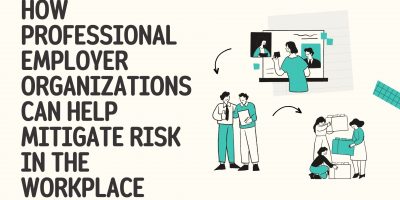
As there’s no such thing as a perfect or risk-free work environment, can PEOs benefit companies in managing threats, and to what extent?

As employee priorities and needs shift, the importance of voluntary benefits in the workplace is increasing.
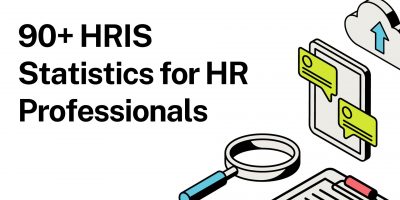
Explore HRIS statistics for informed decision-making and streamlined human resource management.
Used by most of the top employee benefits consultants in the US, Shortlister is where you can find, research and select HR and benefits vendors for your clients.
Shortlister helps you reach your ideal prospects. Claim your free account to control your message and receive employer, consultant and health plan leads.